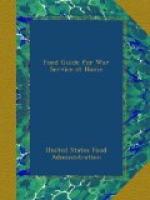Though soy beans and peanuts at least are exceptions, the protein in beans and peas is not so satisfactory as a bodybuilder as that in animal foods, so that a diet in which they are a large part should contain also some milk or eggs or a little meat. Two cups (half a pound) of shelled green peas or beans, or one cup with a cup of skim milk gives as much protein as a quarter of a pound of beef. Dried beans and peas are, of course, cheaper than the canned with their larger amount of water. At the usual market prices as much fuel can be bought for 5 cents spent for dried peas as for 25 cents for canned peas.
Meat-savers do not all have to be high-protein foods, since the diet of most of us contains considerably more protein than is necessary. Any vegetable can be a “meat extender.” The pleasant flavor of meat can be obtained in meat stews, such as the delicious French “pot-au-feu.” Stews can easily be made with less meat and more vegetables than usual. The meat allowance is now so very small in France and the vegetables so scarce in the cities, that the ingenuity of even the French woman is taxed to get a meal.
To Save Wheat. Potatoes to save wheat! The great potato drive to utilize the surplus of our huge 1917 potato-crop, 100,000,000 bushels above normal, has fixed in every one’s mind the interchangeableness of these two foods. Potatoes are one-fifth starch—almost the same quantity as in cooked breakfast cereals. Because of this starch, they give as satisfactory a fuel as wheat or corn or any other cereal. One medium-sized potato supplies the same number of calories as a large slice of bread, and contains more mineral salts than white bread. Europe has learned to eat potatoes instead of wheat. When bread has been short potatoes have been the mainstay in every country. They are to-day the largest single element, in terms of energy, in the German war ration.
Sweet potatoes are also first-class wheat-savers. So to a lesser extent are most vegetables and fruits. Very few except white and sweet potatoes contain much starch, but many of them have considerable sugar, which serves as fuel just as starch does—carrots, beets, onions, parsnips, and practically all fruits such as bananas, oranges, and grapes.
To Save Sugar. We want sugar, of course, both for fuel and flavor. The vegetables and some fruits have their sugar so covered up by other tastes that it does not help to make the food sweet. It does, of course, serve for fuel. Bananas especially are fuel foods, containing much starch when green, which changes to sugar as the fruit ripens. The sweetest fruits are the dried ones—dates, figs, raisins, prunes. They have so much sugar that they can well be used in place of candy.
To Save Fat, Although few common fruits and vegetables contain fat, jam is a real fat-saver. It is of high fuel value, and has the advantage of being a “spreading material” so that it can replace butter with bread and cereals. Jam is of great importance in Europe to-day and all the Governments have taken steps to keep up the supply. It is a regular part of the English army ration.




